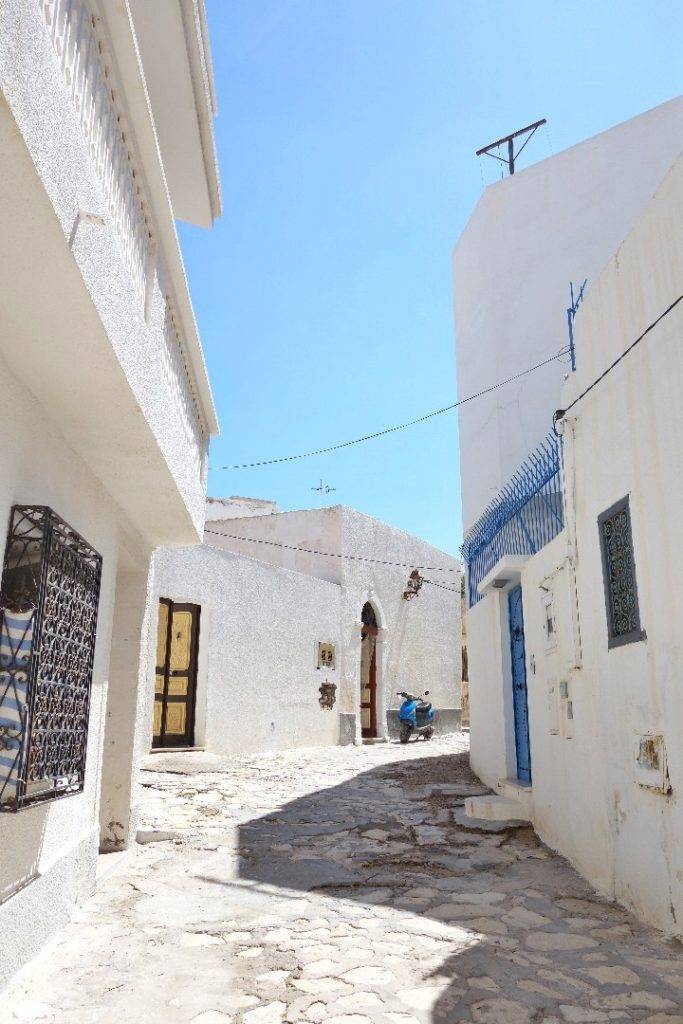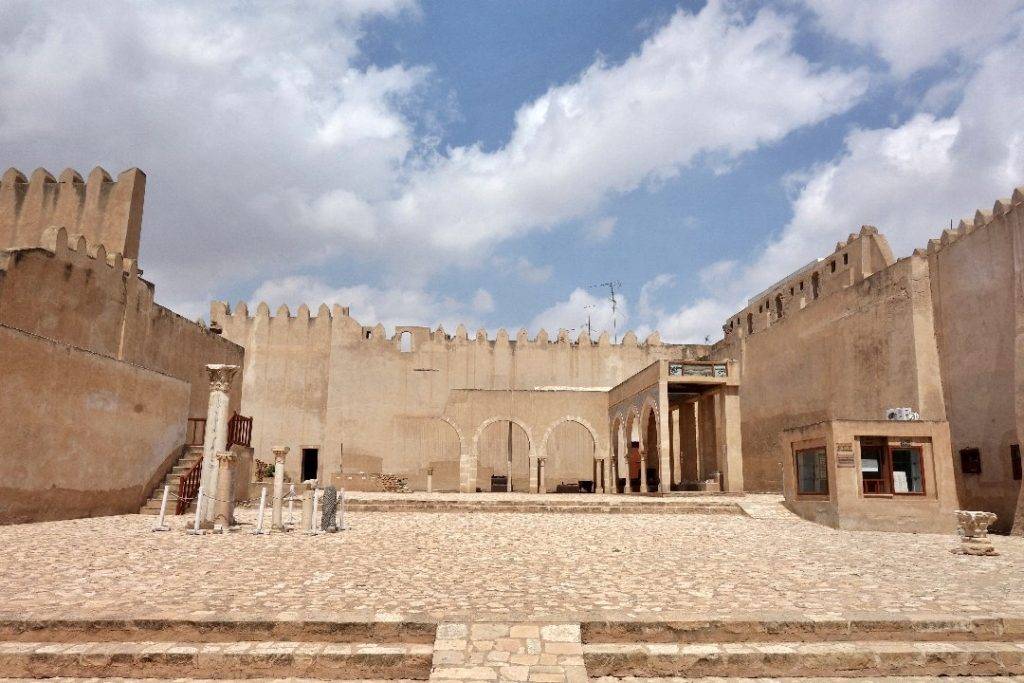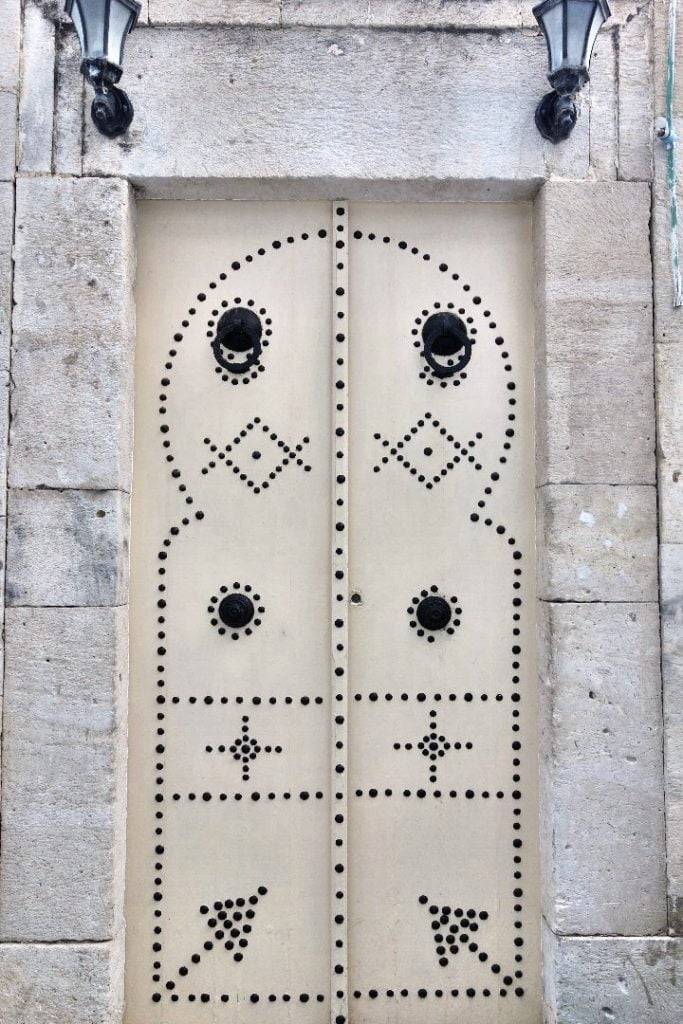Medinas in Tunisia – A walk through History

Last Updated on November 5, 2022
Medina means city in Arabic. Today, it usually refers to the historical part of town, built centuries ago during the Arabs conquest of Africa. In Tunisia, a thick brick wall protects the medina, and there’s always a ribat or kasbah (a fort) as well. Nowadays, most medinas are still standing, and it’s where you’ll find the souk (market) and most of the tourist spots. Don’t hesitate to get out of the main arteries and explore the smaller streets to really get a feel of local life.
Disclaimer: This post contains affiliate links, which means that if you click on any links and make a purchase, I’ll get a small commission, at no cost to you.
Best Medinas in Tunisia:
Tunis
Built in the 7th century, the medina in Tunis is one of the most mesmerizing medinas in Tunisia. Now a UNESCO World Heritage Site, it’s a must-see if you’re planning a visit to Tunisia. Its tiny maze-like streets are full of hidden treasures. From century old houses where artisans practice ancestral arts to little cafés where you’ll enjoy drinking mint tea, sinking in the local atmosphere, Tunis’ Medina is full of treasures.
Check out this Tunis travel guide to go beyond the medina and explore more of Tunis.
Sousse
Sousse is Tunisia’s third largest city and usually gets busy with tourism during summer. It’s a great place if you like beaches and parties. It also makes a great day trip if you just want to visit the medina, a UNESCO world heritage site.
Sousse was founded during the 9th century BC by Phoenicians seamen. The medina was added later on, towards the 9th century. Don’t hesitate to explore the small streets and the local market (avoid going in the morning if you don’t like big crowds, I almost got suffocated to death there).
What to see inside Sousse’s Medina:
- The city walls: built in 859, incorporating some parts of the Byzantine fortress, renovated in 1205 and bombarded in 1943, you’ll notice the hole in the Place des Martyrs, then called the door of the Sea, the sea used to come all the way to the city wall, allowing the boats to enter inside the Medina.
- The Great Mosque: built in the 9th century, only the inside yard can be visited (unless you’re a Muslim), open to visitors from 8 am to 2 pm (only until 11:30 am on Fridays). Entrance fee: 5 dinars
- The Ribat (Fort): The perfect example of Muslim architecture, the ribat was built in 821. From the tower, you’ll get a fantastic view of the medina and the mosque. Open every day from 8 am to 5:30 pm. Entrance fee: 7 dinars.
- Dar Essid: a magnificent example of a traditional house built in the 17th century, still owned by the Essid family. The house can be entirely visited, and everything has been left untouched for centuries.
- The souks (markets): a must-see, each street is reserved for a different trade, from jewelry to spices, you’ll find everything you need. Skip the souvenir area and enter the real souk.
- The Archaeological Museum: Located inside the Kasbah (fortress) and recently renovated, this museum is worth a look. It’s a great place if you like mosaics, some of them are real masterpieces. Entrance fee: 10 dinars, the entrance of the museum is outside of the medina.
Mahdia’s Medina

Mahdia is a smaller and quieter town. This charming city, located on a peninsula, is the perfect place for a stroll through its tiny streets. Towards the end of the peninsula, you’ll see fishermen coming home, passing by the cemetery at the feet of the medina.

The medina here is small and the souk is pretty quiet, it’s the perfect place if you dislike big crowds. Get lost in the small streets and discover the beautiful traditional architecture.

At the main entrance, towards the city, you can visit the small museum and go up to the main city-door through their rooftop. After, enter the medina via the large main gate, Skifa El-Kahla, and enjoy its fresh air, pass by the Great Mosque. Then walk toward the end of the peninsula to get a superb view of the medina and the cemetery. On your way back, stop by the fort Borj El-Kébir built in the 16th century to learn more about the city’s history.

Monastir’s Medina
Founded in 960 BC by the Carthaginians, Monastir, then called Rous Penna, was the starting point of Cesar’s conquest of North Africa. The walls and the old city (medina) you see today were built in 796 when the Arabs took control of the area. Monastir quickly became an important religious and military center. Especially in the 11th century after the Kairouan sacking, a lot of holy men and intellectuals moved to Monastir. After thriving for centuries, Monastir slowly declined because of constant fighting with the Christians but revived in the 16th century thanks to the Ottomans who restored the city.
Monastir’s Ribat was the first one to be built in Africa and is one of the biggest ribats you’ll see in Tunisia. It’s still really well preserved and was restored in the ’70s. You can also take a look at Bourguiba’s Mausoleum, Tunisia’s first president, and do some shopping in the souk.
Check out this article to learn more about Monastir.
Kairouan’s Medina

Up to now, I’ve visited many medinas in Tunisia, and this one is my favorite so far. It’s cleaner than most medinas and it’s in a far better state. Globally the houses have been well preserved and every little street looks so cute. Everything is white and blue with some parts full of plants and flowers. Notice the huge wooden doors, decorated with intricate Muslim symbols.

Tunisia’s spiritual capital, Kairouan is the first sacred place in the Maghreb and the fourth most sacred places in the world for Muslims. Founded in the 7th century, at the beginning of Islam’s expansion, the city was nicknamed “the 300 mosques city”. Now part of the UNESCO World Heritage site, Kairouan has a magical touch attached to it, and a visit to its medina is a must-go if you’re traveling to Tunisia.
There are six main monuments to visit:
- The Aghlabides basin: a huge open-aired reservoir;
- The Great Mosque Jamâa Sidi Oqba: The oldest Muslim religious site in Africa, and one of the best decorated (can only be visited between 8 am and 2 pm);
- Sidi Abid El-Ghariani’s Zaouïa: This Saint’s mausoleum was built in the 14th century and its architecture is a treasure for the eyes;
- Abou Zamâa’s Zaouïa: Abou Zamaâ was a companion of the Prophet Mahomet, his zaouïa is an important place of pilgrimage;
- Sidi Amor Abbada’s Zaouïa: Amor Abbada liked to build all types of things, in his Zaouïa you can take a look at his creations.
- Raqqada Museum of Islamic Arts
To visit these places, you’ll need to first stop at the “Agence de Mise en Valeur du Patrimoine et de Promotion Culturelle” near the Aghlabides basin. The ticket costs 10 dinars and you get access to all the monuments for a day. They close on Mondays. You can also hire an official guide there, but they tend to go fast, so not the best option if you like to take your time and get lost in the small streets.
You can also visit the Dar Hassine Allani; a traditional house turned into a museum and guesthouse. The entrance fee is 10 dinars. You should also take a look at one of the numerous carpet shops, usually in traditional houses, they’re worth a look.
Kairouan is also famous all over Tunisia for its delicious Makroud, a tasty pastry. You’ll find the best ones in the Patisserie Ben Sokrana (rue R’dat-el-Hadid). It’s the oldest pastry shop in the city.
Sfax’s Medina

Sfax is Tunisia second largest city and an industrial hub home to Tunisia’s biggest harbor. The town is rich in fish, phosphates, salt, cereal, and olive trees. Sfax is also a student city with 10% of its population being students. The Sfaxians are known for their way of talking fast and their delicious couscous. Sfax has many beautiful sights to see and things to do, but a day there is enough to discover all of the city’s wonders.
The medina in Sfax is great because Sfax is not a touristy town, so the medina stayed authentic and is not full of souvenir shops. It usually gets hectic, especially on the main streets where the market is held. Under one of the main gates, don’t miss the fish market. Sfaxians eat a lot of fish compared to the rest of Tunisia. You will also find traditional handicrafts, don’t hesitate to get lost in the small streets, you’ll find many workshops there.
Inside the medina, you can visit the Dar Jellouli a traditional house with a patio in the middle and the rooms located around it. The decoration is really nice and well preserved, with a lot of details. The furniture is original, and you’ll see several traditional costumes from Sfax upstairs. On top of the house, the terrace offers a lovely view over the medina. The entrance fee is 5 dinars, plus 1 dinar if you want to take pictures.
A bit farther you’ll find the Ribat (fort) turned into an archaeological museum. They have a small collection of basic objects, nothing spectacular, but the building is worth a look. There you’ll find an underground/cave mosque; it’s hard to imagine how people could pray there. You can also go up the observation tower and walk a bit along the walls. You’ll get a beautiful view of the medina from up there. The entrance fee is 6 dinars.

You can take a look at the Sidi Amar Kammoun minaret as well. Located inside the medina, the mosque is only open to Muslims, but you can still see a lot from the outside. The minaret is the only thing remaining from the 17th-century mosque, the mosque around it has been rebuilt recently. The Great Mosque is also nice, built in the 9th century, its minaret is richly decorated, and can be seen from the Casbah (Ribat).
Other things to do in Sfax:
Unfortunately, the beach in Sfax is not that good. Locals usually go to Chafaar beach, a couple of kilometers away, the beach is clean with clear water and a long stretch of sand.
Near the city center, you’ll find several good chain hotels; otherwise, you can stay inside the medina for a more authentic experience, but don’t expect too much comfort. The hotels inside the medina are usually cheap and simple.
Nearby Sfax, are the Kerkennah islands, a famous holiday destination among locals. The islands are perfect for a day or two of beach time and trekking. Public transportation is scarce so it’s better to have a car or a motorbike to visit the islands. Mostly inhabited by fishermen, the islands are famous for their fish dishes. Once there, you should visit the El-Hsar fort, built during the Roman Empire era and still pretty well preserved. There’s also an interesting museum near Remla about the traditions of the Kerkennah Islands. In El-Attaya, you can witness local life in this small fishing harbor; you also might be invited to attend a local wedding. If you like beaches head for Sidi-Frej, Sidi-Fankhal, Bounoulz or Berdimes. Most of the coast is rocky, if you want a sandy beach, choose Sidi-Fankhal.
Tozeur’s Tunisia

Tozeur’s Medina is special and unique, different from the others in Tunisia, the medina reflects the architecture of the region. The buildings are made of small ocher-colored bricks, assembled to create amazing geometric patterns. The designs usually represent flowers or Quranic verses.
Notice also the massive doors with three knockers, the one on the left for women, the one on the right for men and the one under for children. This way, people inside the house could know who was knocking and, hence, know who had to open the door.
Inside the medina, you can check out the Dar Ben Azouz, a traditional house that you should be able to visit if it’s open (they tend to close whenever they feel like it). You can also visit the Museum of Arts and Traditions (rue de Kairouan). It’s located in an old Koubba (monument elevated on top of a marabout’s tomb) which served as a Quranic school and mosque during the 15th century. Same as for the Dar Ben Azouz, it’s often closed when it should be open.
Thinking of traveling to Tunisia? Check out this guide for tips on other great places to visit.
Like it? Save it for later – Medinas in Tunisia:








































